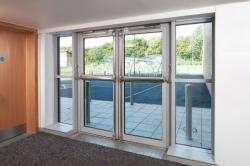Strand Hardware - Barring All Eventualities
 There are a variety of manual and electrical options available for escape door hardware but as with all products, its essential to consider the end user and the environment in which devices are to be placed. The primary purpose of any door on an escape route is for it be readily openable, and the type of premises and its level of occupancy will define whether what type of panic or emergency exit hardware to use.
There are a variety of manual and electrical options available for escape door hardware but as with all products, its essential to consider the end user and the environment in which devices are to be placed. The primary purpose of any door on an escape route is for it be readily openable, and the type of premises and its level of occupancy will define whether what type of panic or emergency exit hardware to use.
The Code of Practice: Hardware for Fire and Escape Doors, published by the Door Hardware Federation (DHF) and the Guild of Architectural Ironmongery (GAI) defines the two:
Panic exit devices to BS EN 1125: These devices are intended primarily for buildings where the public is likely to be present and a panic situation could arise if the building must be evacuated quickly. For this reason, the devices are designed to operate by body pressure alone and require no knowledge of their operation to enable safe and effective evacuation of a building.
Emergency exit devices to BS EN 179: These devices are intended for escape from buildings where the public is unlikely to be present, and where the staff have been trained in emergency procedures and in the use of the specific emergency exit devices fitted. For this reason, panic situations are considered unlikely, and these devices are therefore permitted to have higher operating forces and do not need to release by body pressure alone.
In most cases a mechanical panic device will be the first choice. However, it’s worth considering if the door is to be used for other access requirements and whether users might have accessibility issues. For example, in a hospital or care home, motorised touch bars could provide additional functionality and ease-of-use.
Safety and security will also be a factor. All panic and emergency exit devices provide a level of security against intrusion, but where there is a need for increased security, additional measures can be taken to enhance it without compromising the ability of people to escape during an emergency.
It is essential to liaise with local building and fire authorities to determine building occupancy and undertake risk assessment if such measures are deemed necessary. These can include audible alarms, door monitoring devices and CCTV.
Motorised devices are often used on escape doors which require external access control to restrict who enters a building such as an entrance to a school or college. They are also suitable for use on automatic doors.
Motorised touch bars also provide convenience and enable efficient building management. They can be linked to a variety of access control systems which use swipe card, digital keypad or proximity reader to allow controlled access from outside. They are ideal for large commercial or public buildings and with the addition of a microswitch they can be linked into an estate management off-site control to provide door monitoring.
It is important that any panic exit device is able to operate safely for a realistic lifetime.
BS EN 1125 and BS EN 179 outline testing standards used to verify the durability of products:
Grade 6 - 100 000 test cycles
Grade 7 - 200 000 test cycles - If the escape door to which the panic device is fitted is also used during the day as a normal access door, it is important to ensure that the panic device is Grade 7.
All Strand Hardware panic and emergency exit devices have achieved Grade 7 durability standards and are UKCA marked.
They are also supplied with a maintenance log book that should be passed onto the end user. This includes a table to record weekly and monthly checks which should be undertaken to ensure the device is working correctly.
When it comes to emergency and panic devices, Strand Hardware offers the best way out and we have experts on hand to make selection easier.
For further information about Strand Hardware products email: info@strandhardware.co.uk